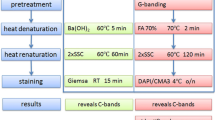Abstract
The structure of reverse (R)-banded and telomeric (T)-banded chromosomes was studied by examination of the same chromosomes first in the light microscope (LM) followed by the scanning electron microscope (SEM). This procedure demonstrated a structural basis to both the R- and T-banding techniques. A direct correlation was shown between the LM staining patterns and the structural patterns observed in the SEM. In the R-banded chromosomes the positively stained R-bands, viewed by LM, corresponded to highly fibrous three-dimensional regions in the SEM. The negatively stained R-interbands corresponded to flatter regions from which material appeared to have been extracted. These structural observations strongly support the suggestion that chromosomal material is preferentially lost from the R-interbands with aggregation of fibres in the R-bands. T-banded chromosomes showed a similar structure to the R-banded chromosomes. The positively stained T-bands located at the telomeres corresponded to regions of highly aggregated fibres. The remainder of the chromosome, corresponding to the negatively stained area, had a flattened and extracted appearance. These similarities in morphology between the T- and R-banded chromosomes support the view that T-bands result from a progressive breakdown of the R-banded chromosome structure.
Similar content being viewed by others
References
Adolph KW (1979) Organisation of chromosomes in mitotic Hela cells. Exp Cell Res 125:95–103
Bahr GF, Larsen PM (1974) Structural “bands” in human chromosomes. In: DuPraw EJ (ed). Advances in cell and molecular biology. Academic Press, New York, pp 191–212
Burkholder GD (1975) The ultrastructure of G- and C-banded chromosomes. Exp Cell Res 90:269–278
Burkholder GD (1981) The ultrastructure of R-banded chromosomes. Chromosoma 83:473–480
Burkholder GD (1982) The mechanisms responsible for reciprocal BrdU-Giemsa staining. Exp Cell Res 141:127–137
Burkholder GD, Duczek LL (1982) The effect of chromosome banding techniques on the proteins of isolated chromosomes. Chromosoma 87:425–435
Comings DE (1973) Biochemical mechanisms of chromosome banding and colour banding with acridine orange. In: Caspersson T, Zeck L (eds) Chromosome identification: Techniques and applications in biology and medicine. Academic Press, New York, pp 292–306
Comings DE (1978) Mechanisms of chromosome banding and implications for chromosome structure. Annu Rev Genet 12:25–46
Comings DE, Avelino E, Okada TA, Wyandt HE (1973) The mechanism of C- and G-banding of chromosomes. Exp Cell Res 77:469–493
DuPraw EJ (1965) Macromolecular organisation of nuclei and chromosomes: A “folded-fiber” model based on whole mount electron microscopy. Nature 206:338–343
Dutrillaux B (1973) Nouveau systeme de marquage chromosomique: Les bandes T. Chromosoma 41:395–402
Dutrillaux B, Covic M (1974) Étude de facteurs influençant la denaturation thermique menagee des chromosomes. Exp Cell Res 85:143–153
Dutrillaux B, Lejeune J (1971) Sur une nouvelle technique d'analyse du caryotype human. C R Seances Acad Sci [III] 272:2638–2640
Finch JT, Klug A (1976) Solenoidal model for superstructure in chromatin. Proc Natl Acad Sci USA 73:1897–1901
Golomb HM, Bahr GF (1974) Human chromatin from interphase to metaphase: A scanning electron microscope study. Exp Cell Res 84:78–87
Goyanes VJ (1985) Electron microscopy of chromosomes. Toward an ultrastructural cytogenetics? Cancer Genet Cytogenet 15:349–367
Haapala O (1984) Metaphase and chromomere banding are distinct entities of chromosome substructure. Hereditas 100:75–81
Harrison CJ, Britch M, Allen TD, Harris R (1981) Scanning electron microscopy of the G-banded human karyotype. Exp Cell Res 134:141–153
Harrison CJ, Allen TD, Britch M, Harris R (1982) High resolution scanning electron microscopy of human metaphase chromosomes. J Cell Sci 56:409–422
Harrison CJ, Allen TD, Harris R (1983) Scanning electron microscopy of variations in human metaphase chromosome structure revealed by giemsa banding. Cytogenet Cell Genet 35:21–27
Harrison CJ, Jack EM, Allen TD, Harris R (1985) Light and scanning electron microscopy of the same human metaphase chromosomes. J Cell Sci 77:143–153
Holmquist G, Gray M, Porter T, Jordan J (1982) Characterization of giemsa dark and light band DNA. Cell 31:121–129
Jack EM, Harrison CJ, Allen TD, Harris R (1985) The structural basis for C-banding. A scanning electron microscopy study. Chromosoma 91:363–368
Marsden MPF, Laemmli UK (1979) Metaphase chromosome structure: evidence for a radial loop model. Cell 17:849–858
Matsumoto Y, Yasuda H, Mita S, Marunouchi T, Yamada M (1980) Evidence for the involvement of H1 histone phosphorylation in chromosome condensation. Nature 284:181–183
McKay RDG (1973) The mechanism of G and C banding in mammalian metaphase chromosomes. Chromosoma 44:1–4
Sandberg AA (1980) The chromosomes in human cancer and leukemia. Elsevier, New York, Amsterdam, p 41
Seabright M (1971) A rapid banding technique for human chromosomes. Lancet ii:971–972
Sehested J (1974) A simple method for R-banding of human chromosomes showing a pH dependent connection between R and B bands. Humangenetik 21:55–58
Yunis JJ, Bahr GF (1979) Chromatin fiber organisation of Human interphase and prophage chromosomes. Exp Cell Res 122:63–72
Author information
Authors and Affiliations
Rights and permissions
About this article
Cite this article
Jack, E.M., Harrison, C.J., Allen, T.D. et al. A structural basis for R- and T-banding: a scanning electron microscopy study. Chromosoma 94, 395–402 (1986). https://doi.org/10.1007/BF00328640
Received:
Issue Date:
DOI: https://doi.org/10.1007/BF00328640




